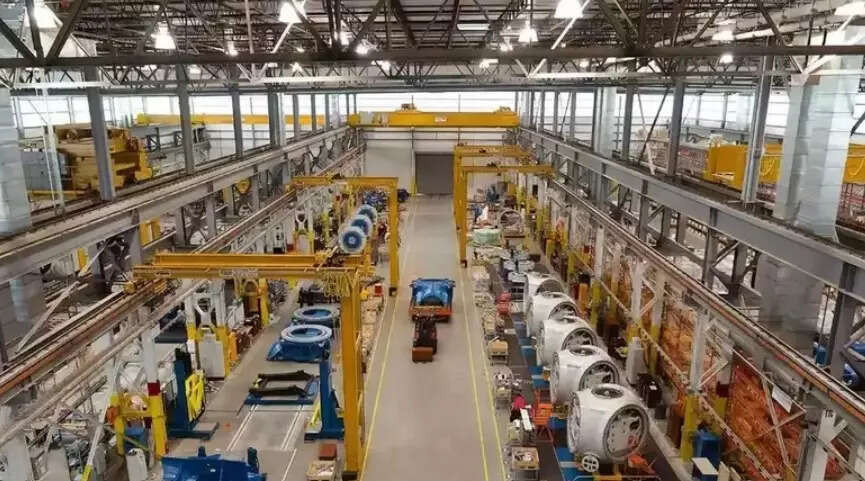India’s Manufacturing Sector Surges, Painting a Rosy Economic Picture
The Indian economy is humming, and the latest data from the manufacturing sector is providing a compelling soundtrack. Forget whispers of slowdown; recent numbers are shouting a story of robust growth, fueled by increased demand and a confident business sentiment. Manufacturing activity has soared to a 16-month high, and the concurrent uptick in GST collections further strengthens the narrative of a vibrant and expanding economic landscape. Let’s dive into the details of this encouraging upswing.
What’s driving this surge in manufacturing? Several factors appear to be converging to create this positive momentum. Firstly, the purchasing managers’ index (PMI) for manufacturing, a key indicator of sector health, has painted a consistently optimistic picture, signaling strong growth in new orders and production volumes. Businesses are not just maintaining current levels; they’re actively scaling up operations to meet rising demand, both domestically and internationally.
This increase in demand reflects a renewed consumer confidence. As economic conditions improve and uncertainties surrounding inflation and global instability ease, consumers are more willing to open their wallets. This translates directly into more orders for manufacturers, who are responding by boosting production and hiring more workers. It’s a virtuous cycle, driving further economic expansion.
GST Collections Reflect a Healthy Economy
Another key indicator that reinforces the positive trend is the steady increase in Goods and Services Tax (GST) collections. GST, a comprehensive indirect tax levied on the supply of goods and services, serves as a reliable barometer of overall economic activity. A rise in GST collections signifies increased transactions and higher sales volumes across various sectors, including manufacturing. The recent 7.5% year-on-year growth in GST inflow is a strong confirmation of this positive trajectory.
This jump isn’t just about increased sales; it also reflects improved tax compliance and efficiency in the GST system. As businesses become more accustomed to the GST regime and streamline their processes, tax evasion becomes more difficult, leading to higher collections for the government. This, in turn, allows the government to invest in infrastructure and social programs, further stimulating economic growth.

The Global Context and India’s Competitive Edge
While the global economy continues to navigate various challenges, India appears to be carving out a distinct path of resilience and growth. Its strong domestic demand, coupled with increasing competitiveness in global markets, is helping it weather external headwinds. Indian manufacturers are increasingly focusing on innovation, quality, and cost-effectiveness, allowing them to compete effectively with their global counterparts.
Moreover, government initiatives aimed at promoting manufacturing, such as the “Make in India” program and production-linked incentive (PLI) schemes, are playing a crucial role in attracting investments and boosting domestic production. These initiatives are not only creating jobs but also fostering a more vibrant and self-reliant manufacturing ecosystem. To read more about government incentives, explore our piece on [India’s evolving economic policies](internal-link-to-related-content).
Challenges and the Path Forward
Of course, no economic upswing is without its potential pitfalls. While the current data is encouraging, it’s important to remain vigilant about potential risks, such as rising raw material costs, supply chain disruptions, and fluctuations in global demand. These challenges could potentially dampen the momentum of the manufacturing sector.
However, with proactive measures and strategic planning, these risks can be effectively mitigated. By investing in infrastructure, promoting innovation, and fostering a skilled workforce, India can solidify its position as a global manufacturing hub and sustain its current growth trajectory. The key is to maintain a focus on long-term sustainable growth, ensuring that the benefits of economic prosperity are shared widely across the population. The recent surge in manufacturing activity is promising, but sustained effort and strategic foresight are essential to building a truly robust and resilient Indian economy.
In conclusion, the recent surge in India’s manufacturing sector, reflected in the impressive PMI and GST collection figures, paints a compelling picture of economic strength and resilience. While challenges remain, the overall outlook is decidedly positive, suggesting that India is well-positioned to continue its growth trajectory and emerge as a major player in the global economy. Continued focus on policy support, infrastructure development, and skills enhancement will be crucial to unlocking the full potential of the Indian manufacturing sector and ensuring sustained economic prosperity.







